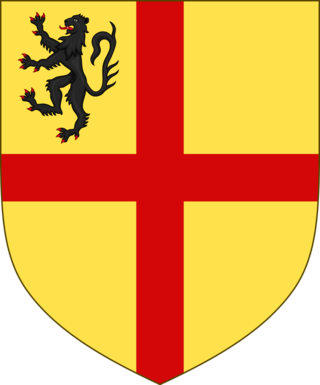Related Research Articles

Sir Turlough Lynagh O'Neill was an Irish Gaelic lord of Tír Eoghain in early modern Ireland. He was inaugurated upon Shane O’Neill’s death, becoming The O'Neill. From 1567 to 1595, Sir Turlough Luineach O'Neill was leader of the O'Neill clan, the most powerful family in Ulster, the northern province in Ireland. He was knighted in 1578.

Rory O'Donnell, 1st Earl of Tyrconnell, was an Irish Gaelic lord, the last King of Tyrconnell. He was a younger brother of Hugh Roe O'Donnell and became the 1st Earl of Tyrconnell.
Hugh Roe O'Donnell, also known as Red Hugh O'Donnell, was a sixteenth-century Irish clan chief, Lord of Tyrconnell, and senior leader during the rising of the Irish clans against English rule in Ireland known as the Nine Years War (1593-1602). While Hiram Morgan has contemptuously dubbed Hugh Roe O'Donnell, "a counter-reformation Irish dynast living in the world of Machiavelli's Prince rather than The Cattle-Raid of Cooley", Morgan also concedes that primary sources other than the Elizabethan era English officials who wrote the Calendar of State Papers depict Hugh Roe as a man who genuinely believed in and lived by the traditional code of conduct demanded of an Irish clan chief. For this reason, Hugh Roe remains an iconic figure in the history of Irish nationalism and has recently drawn comparisons in the Spanish news media to both El Cid and William Wallace.

West Connacht was a kingdom of Gaelic Ireland, associated geographically with present-day County Galway, particularly the area known more commonly today as Connemara. The kingdom represented the core homeland of the Connachta's Uí Briúin Seóla kindred and although they ruled, there were smaller groups of other Gaels in the area, such as the Delbhna Tir Dha Locha and the Conmhaícne Mara. It existed from 1051 onwards, after the Ó Conchobhair, Kings of Connacht, pushed the Ó Flaithbheartaigh to the West of Lough Corrib, from their original territory of Maigh Seóla. Iar Connacht remained a subordinate túath of Connacht, until the 13th century, after which it was more independent.
Ruaidri mac Tairdelbach Ua Conchobair, King of Connacht, died 1384. The previous king though not listed was slain and defeated by the Ó Cellaigh's of Ui Maine.
McCaul, also spelt MacCawell is an Irish surname, derived from the Gaelic Mac Cathmhaoil, meaning the "son of Cathmhaol", descendant of being implied. The name Cathmhaoil itself is derived from cath mhaol meaning "battle chief". The Mac Cathmhaoil were the leading family of Cenél Fearadhaigh, of the Uí Néill, and were based around Clogher in modern-day County Tyrone, Northern Ireland. They were one of the seven powerful septs that supported the O'Neills. Mac Cathmhaoil is now rare in Ulster as it has been Anglicised under various different forms such as, Campbell, McCawl, Caulfield, McCall, Alwell, Callwell, McCowell, Cowell, McCuill, Howell, MacHall, and McQuade.
Lady Fiona O'Donnell, also styled as Dame Fiona O'Donnell, was a Scottish aristocrat and queen consort of Tyrconnell. She is better known by her Irish nickname Iníon Dubh.
Murrough na dTuadh Ó Flaithbheartaigh, anglicised Sir Murrough O'Flaherty was Chief of Iar Connacht,.

Ulick Fionn Burke, 6th Clanricarde or Mac William Uachtar was an Irish chieftain and noble.

Ulick Ruadh Burke, 5th Clanricarde or Mac William Uachtar was an Irish chieftain and noble who was the son of Ulick an Fhiona Burke, 3rd Clanricarde (d.1424).

Donegal Abbey is a ruined Franciscan Priory in Donegal in Ireland. It was constructed by the O'Donnell dynasty in the fifteenth century and remained a center of Classical Christian education even after its destruction during the Nine Years War. It is sometimes referred to as Donegal Friary.
Sir Donal Dubh O'Donnell was a member of the O'Donnell dynasty of Tyrconnell in modern-day County Donegal. He was the eldest son of Sir Hugh McManus O'Donnell, the Lord of Tyrconnell for much of the reign of Elizabeth I.
Nuala O'Donnell was an Irish noblewoman of the O'Donnell dynasty who took part in the Flight of the Earls. She was known as "the Lady of the Piercing Wail".
Tomás Óg Mág Samhradháin was chief of the McGovern Clan and Baron or Lord of Tullyhaw barony, County Cavan from 1584 until his death at the end of the 16th century.
Tomás mac Maghnus Mág Samhradháin was lineage head of the McGoverns and Baron or Lord of Tullyhaw barony, County Cavan from 1512 until his death in 1532.
Cathal mac Aodha Mág Samhradháin or Cathal Mág Samhradháin was chief of the McGovern Clan and Baron or Lord of Tullyhaw barony, County Cavan from 1504 until his death in 1512.
Niall Mag Samhradháin, was chief of the McGovern Clan and either the Baron or the Lord of Tullyhaw barony, County Cavan in modern day Ireland from 1340 until his death in 1359.
Seltanahunshin is a townland in the civil parish of Oughteragh, barony of Carrigallen, County Leitrim, Ireland.

Tirhugh is a barony in County Donegal, Ireland. Baronies were mainly cadastral rather than administrative units. They acquired modest local taxation and spending functions in the 19th century before being superseded by the Local Government (Ireland) Act 1898.
References
- ↑
- Annals of the Four Masters (1998), Annals of the Kingdom of Ireland (Annala Ríoghachta Éireann) from the earliest period to the year 1616 (compiled during the period 1632-1636 by Brother Michael O'Clery et al., and translated and edited by John O'Donovan in 1856), Dublin: De Burca, ISBN 0946130-06-X
- 1 2 Townlands.ie: Derrylahan Townland, Co. Donegal. https://www.townlands.ie/donegal/banagh/kilcar/kilcar/derrylahan/
- ↑ Morgan p.130
- ↑
- O’Donnell, Francis Martin (2018), The O'Donnells of Tyrconnell – A Hidden Legacy, Washington, D.C.: Academica Press LLC, ISBN 978-1-680534740
- ↑ The Annals of the Four Masters, 1590